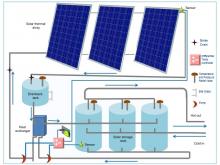As you might expect, a drainback installation for space heating is much like a similar solar thermal system for hot water. However, the space heating setup has three main options.
Single tank for drainback and heat storage
With this setup, the water in the storage tank is the solar fluid: it gets pumped through the collector array by a high-head pump whenever solar energy is available. The pump sits as low as possible, below the water level in the tank, and is switched on by a differential temperature controller . When the water is hot enough, the controller's high limit switches off the pump and all the water drains out of the system, back into the tank.
The heat in the storage tank is passed to the space heating equipment by a submersed heat exchanger. In a combined space heating and hot water setup, a second heat exchanger handles transfer to the domestic hot water supply.
The main problem with this setup is that it can freeze in regions with prolonged cold weather, so if you're installing it in a cold climate you'll need to use an antifreeze mix. The second problem is the head requirement for the pump: drainback systems need the collectors above the tank, so there's a significant amount of head to overcome. DC pumps simply won't work and you'll need to calculate pump size very carefully (from the storage tank to the top of the collectors, plus four feet, as usual).
The advantage of such a system is the same as for all drainback installations: everything simply switches off when it's not in use with no danger of overheating the solar fluid.
 Conventional drainback tank plus storage with heat exchanger(s)
Conventional drainback tank plus storage with heat exchanger(s)
There are two possible configurations here: a single, large storage tank with an internal heat exchanger or multiple, small storage tanks (made of steel) with individual heat exchangers (either internal or wraparound).
With both of these setups, a standard drainback tank is used for the solar fluid, which circulates through the storage tank(s) and passes heat through the heat exchanger(s). Where a single, large storage tank is used, this is quite simple, but the installation can get complicated and expensive when multiple small tanks are used, each with their own exchanger.
The water in the storage tank(s) is used directly in the space heating equipment. In a combined setup where the domestic hot water supply is also heated, the stored water can either be used in both systems directly (as long as the equipment is all rated for potable water) or heat exchangers can be installed in the tank to direct energy to the domestic water tank. If you opt for the heat exchanger method, you'll need another pump and controller to push water from the storage tank into the domestic supply's heat exchanger.
Although it sounds complicated, this setup does not suffer from the height problems encountered by using a single large tank for drainback and storage, because the separate drainback tank can be mounted a fair distance above the storage tank(s). However, the collectors do still